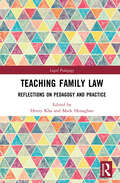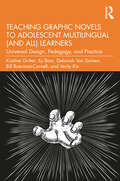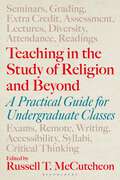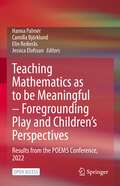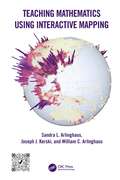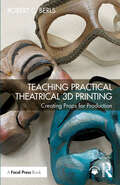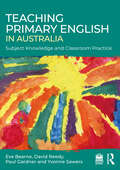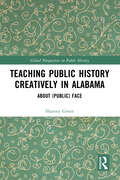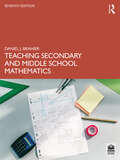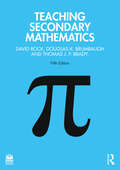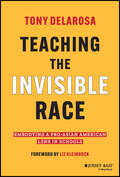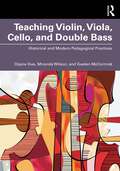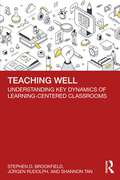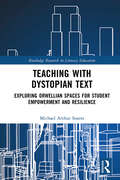- Table View
- List View
Teaching Family Law: Reflections on Pedagogy and Practice (Legal Pedagogy)
by Henry Kha and Mark HenaghanThis book provides a comprehensive analysis of the teaching of an eclectic range of family law topics and the unique opportunities and challenges of teaching family law in different jurisdictions from a varied international perspective. Written by leading legal scholars, the book addresses a gap in the scholarship to comprehensively and systematically analyse the teaching of family law. The first part of the book explores ways of teaching the varied range of topics under the heading of family law and captures the diverse approaches to the discipline. Chapters illustrate how the subject can be best taught in an interdisciplinary way that considers feminist perspectives and the philosophy of teaching, while encompassing legal positivism, empirical research and critical legal theory. The second part of the book examines teaching in different jurisdictions and illustrates policy and practice in Australia, New Zealand, the United States, Canada, the United Kingdom, Hong Kong and South Africa. Showcasing examples of best practice of teaching family law, the book will be an essential reading for legal scholars, as well as researchers and postgraduate students in the fields of family law and legal education.
Teaching Graphic Novels to Adolescent Multilingual (and All) Learners: Universal Design, Pedagogy, and Practice
by Kristine Gritter Xu Bian Deborah Van Duinen Bill Boerman-CornellThis book provides a roadmap for teaching with graphic novels as an effective and engaging approach to advancing reading comprehension for English Learners in secondary schools. Accessibly synthesizing and presenting existing graphic novel research, the authors walk through how to use graphic novels as a teaching tool to improve student motivation and key reading skills, increase their reading proficiency levels, and bolster their vocabulary. The authors provide curricular ideas for teaching multilingual, gifted, and striving readers, along with methods for developing critical literacy and multimodal comprehension. Applying a universal design approach and including examples, current graphic novel recommendations, and pedagogical strategies, this book is essential reading for pre-service teachers in TESOL and literacy education.
Teaching Graphic Novels to Adolescent Multilingual (and All) Learners: Universal Design, Pedagogy, and Practice
by Kristine Gritter Xu Bian Deborah Van Duinen Bill Boerman-CornellThis book provides a roadmap for teaching with graphic novels as an effective and engaging approach to advancing reading comprehension for English Learners in secondary schools. Accessibly synthesizing and presenting existing graphic novel research, the authors walk through how to use graphic novels as a teaching tool to improve student motivation and key reading skills, increase their reading proficiency levels, and bolster their vocabulary. The authors provide curricular ideas for teaching multilingual, gifted, and striving readers, along with methods for developing critical literacy and multimodal comprehension. Applying a universal design approach and including examples, current graphic novel recommendations, and pedagogical strategies, this book is essential reading for pre-service teachers in TESOL and literacy education.
Teaching in the Study of Religion and Beyond: A Practical Guide for Undergraduate Classes
by Russell T. McCutcheonDrawing on their wide experience in the undergraduate classroom, the contributors address basic but current issues in university teaching. This book provides practical commentary and invites instructors to consider how to address the learning needs of their students, while taking into account the wider structural requirements of administrations, governments, or credentialing agencies.Consisting of about forty, readable, short entries – on topics ranging from curriculum, grading, group work, digital humanities and large lectures, to learning management systems, office hours, online/remote courses, recruiting and seminars – this book provides a wealth of practical help and reassurance to teachers working with undergraduate students.This book is a valuable tool for early instructors in universities and colleges, showing them how to impact a class's success. It provides a critical background on the issues involved whilst also offering suggestions on how to navigate the competing demands on teachers.
Teaching Mathematics as to be Meaningful – Foregrounding Play and Children’s Perspectives: Results from the POEM5 Conference, 2022
by Hanna Palmér Camilla Björklund Elin Reikerås Jessica ElofssonThis open access book’s theme is Teaching mathematics as to be meaningful – foregrounding children’s play and perspectives. It discusses the relation between teachers, children and mathematical content within the context of play with a particular focus on the framing of these relations within this context, which is an important theme in the debate on whether teaching should be integrated with or separated from children’s play. The work further addresses meaningfulness in the learning process, particularly from the child’s perspective. Globally, most guidelines and curricula for early childhood education mention play as one of the key features for young children’s learning. Still, there are quite different views on the definitions of play and in what ways play should become part of children’s learning. The chapters of the book mirror the research topics presented at the fifth POEM conference in May 2022 divided into four sub-themes: Play and learning, Children’s perspectives on mathematics, Teachers’ competencies and Theorizing aspects of early mathematics education.
Teaching Mathematics Using Interactive Mapping
by Sandra L. Arlinghaus Joseph J. Kerski William C. ArlinghausTeaching Mathematics Using Interactive Mapping offers novel ways to learn basic math topics such as simple relational measures or measuring hierarchies through customized interactive mapping activities. These activities focus on interactive web-based Geographic Information System (GIS) and are relevant to today’s problems and challenges. Written in a guided, hands-on, understandable manner, all activities are designed to build practical and problem-solving skills that rest on mathematical principles and move students from thinking about maps as references that focus solely on "where is" something, to analytical tools, focusing primarily on the "whys of where." Success with this transition through interaction permits most readers to master mathematical concepts and GIS tools. FEATURES Offers custom-designed geographical activities to fit with specific mathematical topics Helps students become comfortable using mathematics in a variety of professions Provides an innovative, engaging, and practical set of activities to ease readers through typically difficult, often elementary, mathematical topics: fractions, the distributive law, and much more Uses web-based GIS maps, apps, and other tools and data that can be accessed on any device, anywhere, at any time, requiring no prior GIS background Written by experienced teachers and researchers with lifelong experience in teaching mathematics, geography, and spatial analysis This textbook applies to undergraduate and graduate students in universities and community colleges including those in basic mathematics courses, as well as upper-level undergraduate and graduate students taking courses in geographic information systems, remote sensing, photogrammetry, geography, geodesy, information science, engineering, and geology. Professionals interested in learning techniques and technologies for collecting, analyzing, managing, processing, and visualizing geospatial datasets will also benefit from this book as they refresh their knowledge in mathematics.
Teaching Mathematics Using Interactive Mapping
by Sandra L. Arlinghaus Joseph J. Kerski William C. ArlinghausTeaching Mathematics Using Interactive Mapping offers novel ways to learn basic math topics such as simple relational measures or measuring hierarchies through customized interactive mapping activities. These activities focus on interactive web-based Geographic Information System (GIS) and are relevant to today’s problems and challenges. Written in a guided, hands-on, understandable manner, all activities are designed to build practical and problem-solving skills that rest on mathematical principles and move students from thinking about maps as references that focus solely on "where is" something, to analytical tools, focusing primarily on the "whys of where." Success with this transition through interaction permits most readers to master mathematical concepts and GIS tools. FEATURES Offers custom-designed geographical activities to fit with specific mathematical topics Helps students become comfortable using mathematics in a variety of professions Provides an innovative, engaging, and practical set of activities to ease readers through typically difficult, often elementary, mathematical topics: fractions, the distributive law, and much more Uses web-based GIS maps, apps, and other tools and data that can be accessed on any device, anywhere, at any time, requiring no prior GIS background Written by experienced teachers and researchers with lifelong experience in teaching mathematics, geography, and spatial analysis This textbook applies to undergraduate and graduate students in universities and community colleges including those in basic mathematics courses, as well as upper-level undergraduate and graduate students taking courses in geographic information systems, remote sensing, photogrammetry, geography, geodesy, information science, engineering, and geology. Professionals interested in learning techniques and technologies for collecting, analyzing, managing, processing, and visualizing geospatial datasets will also benefit from this book as they refresh their knowledge in mathematics.
Teaching Practical Theatrical 3D Printing: Creating Props for Production
by Robert C. BerlsTeaching Practical Theatrical 3D Printing: Creating Props for Production is a cohesive and practical guide for instructors teaching 3D printing techniques in stagecraft, costume and props courses.Written for the instructor, this book uses non-technical language to explain 3D printers, their workflows and products. Coverage includes the ins and outs of multiple filaments, pros and cons of different types of printers, shop or laboratory setup and safety concerns. The book features lesson plans, rubrics and class-tested sample student projects from design to finished product that highlight learning objectives and methodologies, as well as software and hardware usage explanations and common problems that can occur within design and printing. Step-by-step instructions are included for many types of projects, including fake noses, candlestick phones, buttons, 3D scans, historical recreations and linear actuators. The book also contains examples of poor, average and excellent work with grading explanations and guidance on how to help the student move to the next level with their projects. Chapter objectives, chapter summaries, checklists and reflection points facilitate an instructor in gaining confidence with 3D printers and incorporating their use in the classroom.Teaching Practical Theatrical 3D Printing is an excellent resource for instructors of Props and Costume Design and Construction courses that are interested in using state of the art tools and technology for theatre production.Fully editable files for every object featured in the book are available at www.routledge.com/9781032453279, allowing readers to jump-start their projects and giving them the flexibility to change and redesign the items to best fit their needs.
Teaching Practical Theatrical 3D Printing: Creating Props for Production
by Robert C. BerlsTeaching Practical Theatrical 3D Printing: Creating Props for Production is a cohesive and practical guide for instructors teaching 3D printing techniques in stagecraft, costume and props courses.Written for the instructor, this book uses non-technical language to explain 3D printers, their workflows and products. Coverage includes the ins and outs of multiple filaments, pros and cons of different types of printers, shop or laboratory setup and safety concerns. The book features lesson plans, rubrics and class-tested sample student projects from design to finished product that highlight learning objectives and methodologies, as well as software and hardware usage explanations and common problems that can occur within design and printing. Step-by-step instructions are included for many types of projects, including fake noses, candlestick phones, buttons, 3D scans, historical recreations and linear actuators. The book also contains examples of poor, average and excellent work with grading explanations and guidance on how to help the student move to the next level with their projects. Chapter objectives, chapter summaries, checklists and reflection points facilitate an instructor in gaining confidence with 3D printers and incorporating their use in the classroom.Teaching Practical Theatrical 3D Printing is an excellent resource for instructors of Props and Costume Design and Construction courses that are interested in using state of the art tools and technology for theatre production.Fully editable files for every object featured in the book are available at www.routledge.com/9781032453279, allowing readers to jump-start their projects and giving them the flexibility to change and redesign the items to best fit their needs.
Teaching Primary English in Australia: Subject Knowledge and Classroom Practice
by Eve Bearne David Reedy Paul Gardner Yvonne SawersThis first Australian edition of Teaching Primary English has been updated and adapted to reflect the Australian sociocultural and educational context. This text provides a comprehensive, evidence informed introduction to teaching and learning English in the primary school classroom. New content refers to the Australian English Curriculum and incorporates Aboriginal and Torres Strait Islander perspectives and literacy perspectives relevant to the Asia-Pacific region as well as the broader international context. This edition also includes a new section devoted to visual literacy, critical literacy and multimodality. Teaching advice and ideas are supported by practical examples linked to video clips filmed in real schools, reflective activities, observational tasks and online resources. Each section includes suggestions for great children’s literature and offers assessment advice and support for planning for diversity and special educational needs. Drawing on the very latest research and theory, supported by practical examples and guidance, this is an essential resource for pre-service teachers as they develop subject knowledge and the skills and confidence to deliver effective and engaging classroom practice.
Teaching Primary English in Australia: Subject Knowledge and Classroom Practice
by Eve Bearne David Reedy Paul Gardner Yvonne SawersThis first Australian edition of Teaching Primary English has been updated and adapted to reflect the Australian sociocultural and educational context. This text provides a comprehensive, evidence informed introduction to teaching and learning English in the primary school classroom. New content refers to the Australian English Curriculum and incorporates Aboriginal and Torres Strait Islander perspectives and literacy perspectives relevant to the Asia-Pacific region as well as the broader international context. This edition also includes a new section devoted to visual literacy, critical literacy and multimodality. Teaching advice and ideas are supported by practical examples linked to video clips filmed in real schools, reflective activities, observational tasks and online resources. Each section includes suggestions for great children’s literature and offers assessment advice and support for planning for diversity and special educational needs. Drawing on the very latest research and theory, supported by practical examples and guidance, this is an essential resource for pre-service teachers as they develop subject knowledge and the skills and confidence to deliver effective and engaging classroom practice.
Teaching Public History Creatively in Alabama: About (Public) Face (Global Perspectives on Public History)
by Sharony GreenThis book chronicles a University of Alabama historian’s efforts to engage public history over the course of a decade, highlighting personal and educational experiences inside and outside of the classroom.Each chapter reveals how Sharony Green, her students, and collaborators used various public places and spaces in Alabama, including the University of Alabama and Tuscaloosa, where she teaches, as “labs” to learn more about our shared past. Inspired by her familiar beginnings in a historic community in Miami, Florida, the author, a descendant of people from the American South and the Bahamas, unveils her encounters with the built environment, old documents and objects, motion pictures, music, and all kinds of historical actors. The book shares a variety of projects including exhibits and displays, images, videos, songs, and poetry, that serve as manifestations of her encounters with the places around her and her students. Together, these stories uncover an unexpected journey into public history, offering new ways to think about the field and humanities more generally.Teaching Public History Creatively in Alabama is an enlightening resource to both intentional and unintentional practitioners of public history, including scholars, students, and general readers interested in connecting with the past.
Teaching Public History Creatively in Alabama: About (Public) Face (Global Perspectives on Public History)
by Sharony GreenThis book chronicles a University of Alabama historian’s efforts to engage public history over the course of a decade, highlighting personal and educational experiences inside and outside of the classroom.Each chapter reveals how Sharony Green, her students, and collaborators used various public places and spaces in Alabama, including the University of Alabama and Tuscaloosa, where she teaches, as “labs” to learn more about our shared past. Inspired by her familiar beginnings in a historic community in Miami, Florida, the author, a descendant of people from the American South and the Bahamas, unveils her encounters with the built environment, old documents and objects, motion pictures, music, and all kinds of historical actors. The book shares a variety of projects including exhibits and displays, images, videos, songs, and poetry, that serve as manifestations of her encounters with the places around her and her students. Together, these stories uncover an unexpected journey into public history, offering new ways to think about the field and humanities more generally.Teaching Public History Creatively in Alabama is an enlightening resource to both intentional and unintentional practitioners of public history, including scholars, students, and general readers interested in connecting with the past.
Teaching Secondary and Middle School Mathematics
by Daniel J. BrahierTeaching Secondary and Middle School Mathematics combines the latest developments in research, technology, and standards with a vibrant writing style to help teachers prepare for the excitement and challenges of teaching secondary and middle school mathematics. The book explores the mathematics teaching profession by examining the processes of planning, teaching, and assessing student progress through practical examples and recommendations. Beginning with an examination of what it means to teach and learn mathematics, the reader is led through the essential components of teaching, concluding with an examination of how teachers continue with professional development throughout their careers. Hundreds of citations are used to support the ideas presented in the text, and specific websites and other resources are presented for future study by the reader. Classroom scenarios are presented to engage the reader in thinking through specific challenges that are common in mathematics classrooms. The seventh edition has been updated and expanded with particular emphasis on the latest technology, standards, and other resources. The reader is introduced to the ways that students think and how to best meet their needs through planning that involves attention to differentiation, as well as how to manage a classroom for success. Features include: • Following on from the sixth edition, assessment takes a central role in planning and teaching. Unit 3 (of 5) addresses the use of summative and formative assessments to inform classroom teaching practices. • A new appendix is included that lists websites that can be used in a methods class to view other teachers interacting with students for discussion of effective teaching practices. • The feature entitled “Links and Resources” has been updated in each of the 13 chapters. Five strongly recommended and practical resources are spotlighted at the end of each chapter as an easy reference to some of the most important materials on the topic. • Approximately 150 new citations have either replaced or been added to the text to reflect the latest in research, materials, and resources that support the teaching of mathematics. • Significant revisions have been made to Chapter 12, which now includes updated research and practices as well as a discussion on culturally responsive pedagogy. Likewise, Chapter 8 now includes a description of best and high-leverage teaching practices, and a discussion in Chapter 11 on alternative high school mathematics electives for students has been added. • Chapter 9, on the practical use of classroom technology, has again been revised to reflect the latest tools available to classroom teachers, including apps that can be run on handheld personal devices, in light of changes in education resulting from the global pandemic. An updated Instructor’s Manual features a test bank, sample classroom activities, PowerPoint slide content, chapter summaries, and learning outcomes for each chapter, and can be accessed by instructors online at www.routledge.com/9781032472867.
Teaching Secondary and Middle School Mathematics
by Daniel J. BrahierTeaching Secondary and Middle School Mathematics combines the latest developments in research, technology, and standards with a vibrant writing style to help teachers prepare for the excitement and challenges of teaching secondary and middle school mathematics. The book explores the mathematics teaching profession by examining the processes of planning, teaching, and assessing student progress through practical examples and recommendations. Beginning with an examination of what it means to teach and learn mathematics, the reader is led through the essential components of teaching, concluding with an examination of how teachers continue with professional development throughout their careers. Hundreds of citations are used to support the ideas presented in the text, and specific websites and other resources are presented for future study by the reader. Classroom scenarios are presented to engage the reader in thinking through specific challenges that are common in mathematics classrooms. The seventh edition has been updated and expanded with particular emphasis on the latest technology, standards, and other resources. The reader is introduced to the ways that students think and how to best meet their needs through planning that involves attention to differentiation, as well as how to manage a classroom for success. Features include: • Following on from the sixth edition, assessment takes a central role in planning and teaching. Unit 3 (of 5) addresses the use of summative and formative assessments to inform classroom teaching practices. • A new appendix is included that lists websites that can be used in a methods class to view other teachers interacting with students for discussion of effective teaching practices. • The feature entitled “Links and Resources” has been updated in each of the 13 chapters. Five strongly recommended and practical resources are spotlighted at the end of each chapter as an easy reference to some of the most important materials on the topic. • Approximately 150 new citations have either replaced or been added to the text to reflect the latest in research, materials, and resources that support the teaching of mathematics. • Significant revisions have been made to Chapter 12, which now includes updated research and practices as well as a discussion on culturally responsive pedagogy. Likewise, Chapter 8 now includes a description of best and high-leverage teaching practices, and a discussion in Chapter 11 on alternative high school mathematics electives for students has been added. • Chapter 9, on the practical use of classroom technology, has again been revised to reflect the latest tools available to classroom teachers, including apps that can be run on handheld personal devices, in light of changes in education resulting from the global pandemic. An updated Instructor’s Manual features a test bank, sample classroom activities, PowerPoint slide content, chapter summaries, and learning outcomes for each chapter, and can be accessed by instructors online at www.routledge.com/9781032472867.
Teaching Secondary Mathematics
by David Rock Douglas K. Brumbaugh Thomas J. BradySolidly grounded in up-to-date research, theory, and technology, Teaching Secondary Mathematics is a practical, student-friendly, and popular text for secondary mathematics methods courses. It provides clear and useful approaches for mathematics teachers and shows how concepts typically found in a secondary mathematics curriculum can be taught in a positive and encouraging way. The thoroughly revised fifth edition combines this pragmatic approach with truly innovative and integrated technology content throughout. Synthesized content between the book and a comprehensive Instructor and Student Resource website offers expanded discussion of chapter topics, additional examples, and technological tips, such as using and assessing artificial intelligence.Each chapter features tried-and-tested pedagogical techniques, problem-solving challenges, discussion points, activities, mathematical challenges, and student-life-based applications that will encourage students to think and do.New to the fifth edition: A fully revised chapter on technological advancements in the teaching of mathematics, including the use of artificial intelligence A new chapter on equity, shame, and anxiety in the mathematics classroom Connections to both the updated National Council of Teachers of Mathematics (NCTM) Focal Points and Standards Problem-solving challenges and sticky questions featured in each chapter to encourage students to think through everyday issues and possible solutions A fresh interior design to better highlight pedagogical elements and key features A completely updated Instructor and Student Resource site with chapter-by-chapter video lessons, teacher tools, problem solving Q&As, exercises, and helpful links and resources.
Teaching Secondary Mathematics
by David Rock Douglas K. Brumbaugh Thomas J. BradySolidly grounded in up-to-date research, theory, and technology, Teaching Secondary Mathematics is a practical, student-friendly, and popular text for secondary mathematics methods courses. It provides clear and useful approaches for mathematics teachers and shows how concepts typically found in a secondary mathematics curriculum can be taught in a positive and encouraging way. The thoroughly revised fifth edition combines this pragmatic approach with truly innovative and integrated technology content throughout. Synthesized content between the book and a comprehensive Instructor and Student Resource website offers expanded discussion of chapter topics, additional examples, and technological tips, such as using and assessing artificial intelligence.Each chapter features tried-and-tested pedagogical techniques, problem-solving challenges, discussion points, activities, mathematical challenges, and student-life-based applications that will encourage students to think and do.New to the fifth edition: A fully revised chapter on technological advancements in the teaching of mathematics, including the use of artificial intelligence A new chapter on equity, shame, and anxiety in the mathematics classroom Connections to both the updated National Council of Teachers of Mathematics (NCTM) Focal Points and Standards Problem-solving challenges and sticky questions featured in each chapter to encourage students to think through everyday issues and possible solutions A fresh interior design to better highlight pedagogical elements and key features A completely updated Instructor and Student Resource site with chapter-by-chapter video lessons, teacher tools, problem solving Q&As, exercises, and helpful links and resources.
Teaching the Invisible Race: Embodying a Pro-Asian American Lens in Schools
by Tony DelaRosaTransform How You Teach Asian American Narratives in your Schools! In Teaching the Invisible Race, anti-bias and anti-racist educator and researcher Tony DelaRosa (he, siya) delivers an insightful and hands-on treatment of how to embody a pro-Asian American lens in your classroom while combating anti-Asian hate in your school. The author offers stories, case studies, research, and frameworks that will help you build the knowledge, mindset, and skills you need to teach Asian-American history and stories in your curriculum. You’ll learn to embrace Asian American joy and a pro-Asian American lens—as opposed to a deficit lens—that is inclusive of Brown and Southeast Asian American perspectives and disability narratives. You’ll also find: Self-interrogation exercises regarding major Asian American concepts and social movements Ways to center Asian Americans in your classroom and your school Information about how white supremacy and anti-Blackness manifest in relation to Asian America, both internally and externallyAn essential resource for educators, school administrators, and K-12 school leaders, Teaching the Invisible Race will also earn a place in the hands of parents, families, and community members with an interest in advancing social justice in the Asian American context.
Teaching the Invisible Race: Embodying a Pro-Asian American Lens in Schools
by Tony DelaRosaTransform How You Teach Asian American Narratives in your Schools! In Teaching the Invisible Race, anti-bias and anti-racist educator and researcher Tony DelaRosa (he, siya) delivers an insightful and hands-on treatment of how to embody a pro-Asian American lens in your classroom while combating anti-Asian hate in your school. The author offers stories, case studies, research, and frameworks that will help you build the knowledge, mindset, and skills you need to teach Asian-American history and stories in your curriculum. You’ll learn to embrace Asian American joy and a pro-Asian American lens—as opposed to a deficit lens—that is inclusive of Brown and Southeast Asian American perspectives and disability narratives. You’ll also find: Self-interrogation exercises regarding major Asian American concepts and social movements Ways to center Asian Americans in your classroom and your school Information about how white supremacy and anti-Blackness manifest in relation to Asian America, both internally and externallyAn essential resource for educators, school administrators, and K-12 school leaders, Teaching the Invisible Race will also earn a place in the hands of parents, families, and community members with an interest in advancing social justice in the Asian American context.
Teaching Violin, Viola, Cello, and Double Bass: Historical and Modern Pedagogical Practices
by Dijana Ihas Miranda Wilson Gaelen McCormickTeaching Violin, Viola, Cello, and Double Bass summarizes three centuries of string pedagogy treatises to create a comprehensive resource on methods and approaches to teaching all four bowed string instruments. Co-written by three performance and pedagogy experts, each specializing in different string instruments, this book is applicable to all levels of instruction.Essays on historical pedagogues are clearly structured to allow for easy comprehension of their philosophies, pedagogical practices, and unique contributions. This book concludes with a section on application through comparative analysis of the historical methods and approaches.With coverage from the eighteenth century to the present, this book will be invaluable for teachers and students of string pedagogy and general readers who wish to learn more about string pedagogy’s rich history, diverse content, and modern developments.
Teaching Violin, Viola, Cello, and Double Bass: Historical and Modern Pedagogical Practices
by Dijana Ihas Miranda Wilson Gaelen McCormickTeaching Violin, Viola, Cello, and Double Bass summarizes three centuries of string pedagogy treatises to create a comprehensive resource on methods and approaches to teaching all four bowed string instruments. Co-written by three performance and pedagogy experts, each specializing in different string instruments, this book is applicable to all levels of instruction.Essays on historical pedagogues are clearly structured to allow for easy comprehension of their philosophies, pedagogical practices, and unique contributions. This book concludes with a section on application through comparative analysis of the historical methods and approaches.With coverage from the eighteenth century to the present, this book will be invaluable for teachers and students of string pedagogy and general readers who wish to learn more about string pedagogy’s rich history, diverse content, and modern developments.
Teaching Well: Understanding Key Dynamics of Learning-Centered Classrooms
by Stephen D. Brookfield Jürgen Rudolph Shannon TanWhat does it mean to teach well? In short, it means a willingness to do anything that helps students learn. Teaching Well investigates the fundamental principle of what teaching effectively entails by exploring the key dynamics of a learning-centered classroom. Based on interviews with renowned scholar Stephen D. Brookfield, this book covers a wide range of topics – such as classroom democratization, critical thinking and reflection, race and power, and more. Each chapter is framed by key questions meant to hone teachers’ crafts and encourage important conversations. Further, this engaging book examines the crucial steps of bringing educators’ identities and backgrounds into practice by soliciting and responding to student feedback, negotiating power dynamics, and the ways institutional constraints, students, and self-concepts can sabotage efforts. A timely text, Teaching Well is the ideal companion for all college and university educators and experienced practitioners across the globe who continue to reflect critically about their teaching practice.
Teaching Well: Understanding Key Dynamics of Learning-Centered Classrooms
by Stephen D. Brookfield Jürgen Rudolph Shannon TanWhat does it mean to teach well? In short, it means a willingness to do anything that helps students learn. Teaching Well investigates the fundamental principle of what teaching effectively entails by exploring the key dynamics of a learning-centered classroom. Based on interviews with renowned scholar Stephen D. Brookfield, this book covers a wide range of topics – such as classroom democratization, critical thinking and reflection, race and power, and more. Each chapter is framed by key questions meant to hone teachers’ crafts and encourage important conversations. Further, this engaging book examines the crucial steps of bringing educators’ identities and backgrounds into practice by soliciting and responding to student feedback, negotiating power dynamics, and the ways institutional constraints, students, and self-concepts can sabotage efforts. A timely text, Teaching Well is the ideal companion for all college and university educators and experienced practitioners across the globe who continue to reflect critically about their teaching practice.
Teaching with Dystopian Text: Exploring Orwellian Spaces for Student Empowerment and Resilience (Routledge Research in Literacy Education)
by Michael Arthur SoaresTeaching with Dystopian Text propounds an exchange of spatial to pedagogical practices centered around “Orwellian Spaces,” signaling a new utility for teaching with dystopian texts in secondary education. The volume details the urgency of dystopian texts for secondary students, providing theoretical frameworks, classroom examples and practical research. The function of dystopian texts, such as George Orwell’s 1984, as social and political critique is demonstrated as central to their power. Teaching with Dystopian Text: Exploring Orwellian Spaces for Student Empowerment and Resilience makes a case that dystopian texts can be instrumental in the transfer of spatial practices to pedagogical practices. Pedagogical application creates links between the text and the student through defamiliarization, connecting the student to practices of resistance in the space of the classroom. The volume also addresses the challenges of teaching dystopian text in a dystopian educational climate including the COVID-19 lockdown. In addition to appealing to scholars and researchers of literacy education, language education and dystopian text, this book will also be a powerful yet accessible resource for secondary teachers as they address dystopian concerns with students in the complicated twenty-first century.
Teaching with Dystopian Text: Exploring Orwellian Spaces for Student Empowerment and Resilience (Routledge Research in Literacy Education)
by Michael Arthur SoaresTeaching with Dystopian Text propounds an exchange of spatial to pedagogical practices centered around “Orwellian Spaces,” signaling a new utility for teaching with dystopian texts in secondary education. The volume details the urgency of dystopian texts for secondary students, providing theoretical frameworks, classroom examples and practical research. The function of dystopian texts, such as George Orwell’s 1984, as social and political critique is demonstrated as central to their power. Teaching with Dystopian Text: Exploring Orwellian Spaces for Student Empowerment and Resilience makes a case that dystopian texts can be instrumental in the transfer of spatial practices to pedagogical practices. Pedagogical application creates links between the text and the student through defamiliarization, connecting the student to practices of resistance in the space of the classroom. The volume also addresses the challenges of teaching dystopian text in a dystopian educational climate including the COVID-19 lockdown. In addition to appealing to scholars and researchers of literacy education, language education and dystopian text, this book will also be a powerful yet accessible resource for secondary teachers as they address dystopian concerns with students in the complicated twenty-first century.
